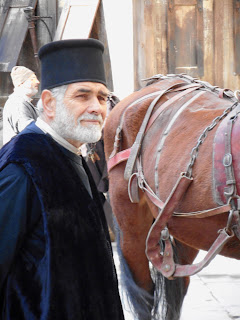We also knew that before he became Pope, Pius II was known as Enea Silvio Piccolomini.
We knew the Piccolomini family had been local nobility in the Val d'Orcia back to the time Pienza was known as Corsignano.
We figured it was time to learn more about the family.
At the right is the Piccolomini coat of arms. It will play a prominent role in our quest for more of the family history.
First record of the Piccolomini family comes from the year 1220, when the Holy Roman Emperor gave a grant of land in the Val d'Orcia to the family as a reward for loyal service. This loyalty to the emperor would shape the family's history for the next 300 years.
As the Renaissance dragged the Italian economy from feudal to modern, friction developed between the new merchant class (known as the Guelphs...who supported the Popes) and the landed aristocrats (known as the Ghibelline...who backed the Holy Roman Emperor). This friction erupted into a full-scale civil war in Tuscany that lasted 150 years.

By the year 1400, the Piccolomini's were well established in Siena as well as the Val d'Orcia.
There are signs of it around the old city.
When her became pope, Pius II built a large palazzo just a three-minute walk from the Campo (Siena's Main piazza...pictured above).

Today that palazzo houses, among other things, a pizzeria named "Below the House of the Pope."
The fortunes of the Piccolomini family waxed and waned along with their Ghibelline allies all through the long civil war. Three times they were run out of Siena, only to return when their faction regained power.
By looking carefully for the family coat of arms, you can see where in Siena the Piccolomini family exerted influence. In the case of the crest at the left, it's on a building that now houses a sporting goods retailer.
More impressive is their crest on this building...corporate headquarters of the Banca Monte dei Paschi di Siena.
The bank was founded in 1472, making it the world's oldest functioning bank, and one of Italy's largest.
Just below the bottom row of windows are the family crests of the founders...the Piccolomini coat of arms prominent among them.
Over the years, the family produced its share of notables: two popes, a cardinal, head of the Jesuits, an astronomer who discovered craters on the moon, and the patron of Galileo Galilei.
The Siena Cathedral is no doubt the city's most grandiose building.
The Cathedral dates back to 1215. The large front doors (that's Carol standing in front of them) are that tall because mounted knights, armed with their lances, could enter the Cathedral to be blessed before heading off to war.
The marble of the interior is set in black and white stripes, the colors of the city. It contains sculptures by Michelangelo, Bernini, and Donatello.
It also contains a lasting tribute to the Piccolomini family.
In a prominent position just to the left of the Cathedral's apse, is a monument to Pope Pio II, the builder of Pienza.
Across the nave is a similar statue of his nephew, who became Pope Pius III.

Pius III is an interesting footnote in the history of the Papacy.
In 1503, when the first Borgia Pope, Alexander VI died, The College of Cardinals deadlocked when voting for his successor. Neither the supporters of the Borgias nor the supporters of the Rovere family could muster a majority. As a compromise, the College selected Francesco Piccolomini, an ailing but well-respected member of the Papal Curia. Francesco chose the name Pius III, out of respect for his more famous uncle.
Twenty-six days after his selection as Pope, Pius III died. The official record lists the cause of death as gout, but rumors at the time said he was poisoned.
Pius III's most notable achievement resides in the Siena Cathedral. Again, the family coat of arms provides the clue.
On either side of a small door inside the Cathedral are carved the Piccolomini coat of arms. Because the crest is topped by a cardinal's hat instead of the Pope's mitre, you can tell what's inside was done at the behest of a Pius III when he was a cardinal.
And what's inside those doors is spectacular:
The Piccolomini Library.
It contains:

The world's largest collection of illustrated Medieval manuscripts on display.
As well as a series of frescos depicting the life and accomplishments of Pope Pius II, painted by the Umbrian artist known as Pinturicchio, whose other claim to fame is as the teacher of Raphael.

Enea Silvio Piccolomini, before he became Pope Pius II, was an accomplished diplomat.
He negotiated a truce between the warring Scots and English.
He negotiated the tricky betrothal of the Holy Roman Emperor to the Princess of Portugal, thus ending the centuries-long feud between the Emperor and the Papal States.
As a reward for his diplomatic skills, Piccolomini was made a Cardinal in 1456.

Once elected Pope, he tried to settle with the Ottoman Turks, who were moving north, towards Hungary, conquering the Balkans as they went.
When that didn't work, he called a conclave in Mantua to organize a final "Crusade" against the Turks.

The interested parties signed on, but only the Venetians actually mounted a fleet. The war effort sputtered to a halt.
Pius II understood the threat to Europe that the Turks posed (60 years later Suliman would lay siege to Vienna, the capital of the Holy Roman Empire).
He personally took charge of the Crusade, traveling to Ancona to prod the assembled armies into action. There, he fell ill with malaria and died.
So, today, the Piccolomini family heritage remains alive...in a beautiful library that preserves some of the greatest art from the Middle Ages...

...in Italy's third largest bank,
...and in Pienza, la cite' di nostro couri (the home of our hearts).











































